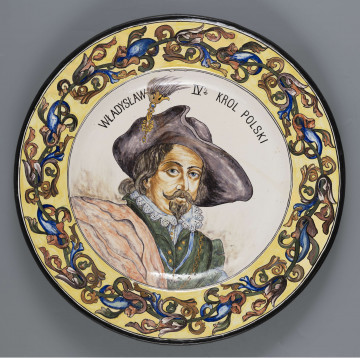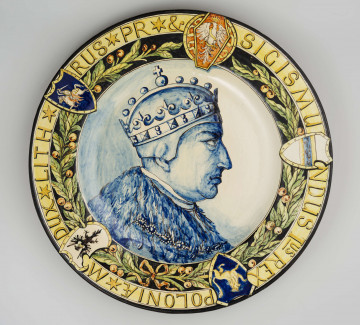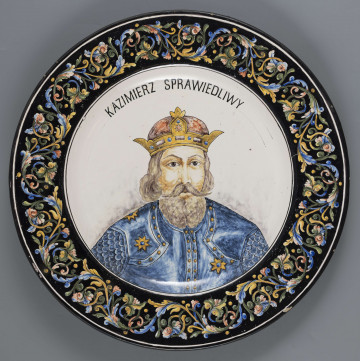
Platter with a bust of Władysław IV
1882 — 1885
National Museum in Lublin
Part of the collection: Majolica from Nieborów
In 1881, when founding the Artistic Faience and Tile Stoves Factory, Prince Michał Piotr Radziwiłł was acting on the wave of the then-popular positivist idea of the renewal of society. The slogans of organic work and work from the ground up inspired and stimulated the search for a renewed form of handicraft or the Polish version of 'art applied to industry'.
Initially, the forms of vessels and decorative motifs were based on historical patterns of Italian maiolica workshops in Urbino, Faenza, French manufactories in Nevers, Moustiers and Rouen, and the Dutch one in Delft. Later, a series of decorations with national motifs and patriotic content drawn from Polish history and the native landscape, was created under the influence of Bolesław Prus's press criticism.
It manufactured products using its own designs, employing talented local craftsmen and self-made artists coming from the impoverished landed gentry of the countryside and adepts of the Warsaw drawing school.
Feliks Szewczyk (1863-1932) was a painter cooperating with the manufactory. He painted decorations on the surface of vessels. Using both ceramic paints and watercolour compositions created on paper, he primarily depicted lancer themes. He was excellent at painting horses using dynamic composition. He became known as a draughtsman and illustrator of books for young people, as exemplified by the poem Rapsod rycerski (Knight Rhapsody) by Franciszek Jasieńczyk.
Szewczyk painted the equestrian portrait of Prince Józef Poniatowski on the plate, which is confirmed by the signature placed on the bottom of the dish. The style of composition, colours, free painting technique – capturing the elegance of the mount's movement – are characteristic features of the little-known painter’s workshop.
Magdalena Norkowska
Author / creator
Dimensions
cały obiekt: width: 4 cm
Object type
dish
Technique
ceramic technique
Material
faience
Creation time / dating
Creation / finding place
Owner
The National Museum in Lublin
Identification number
Location / status

1882 — 1885
National Museum in Lublin

1882 — 1885
National Museum in Lublin

1882 — 1885
National Museum in Lublin
DISCOVER this TOPIC
National Museum in Lublin
DISCOVER this PATH
Educational path